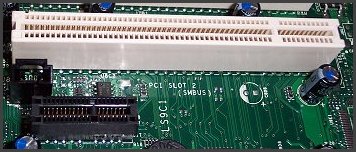PCI Express
Along with DDR-II memory support, PCI Express is the largest visible architectural difference compared to previous Intel desktop platforms. Supplanting both AGP for graphics interconnects and regular PCI for peripheral interconnects, PCI Express is a high speed serial bus that supports the next generation of high bandwidth peripheral devices.The PCI Express standard defines a single PCI Express lane, a 500MB/sec chunk of bandwidth in one direction at a time, from the peripheral to the host or in the other direction. Lanes are then combined to provide a standard interface for the class of peripheral that will ride the resulting bus. Current lane groups defined are 1x, 2x, 4x and 16x, the top 16x spec reserved for graphics cards, the lesser lane groups used by add-in peripheral cards.
With the basic 1x lane spec providing 500MB/sec of bandwidth, it seems perfect for add-in RAID controllers and high bandwidth video and audio capture boards. The 16x graphics spec (PEG16) groups 16 1x lanes into a split 8/8 upstream/downstream configuration. That means 4GB/sec upstream from host to GPU, twice the bandwidth of an upstream AGP8X connection, with 4GB/sec for GPU to host traffic that can occur at the same time as any upstream transfer.
With AGP8X's downstream bandwidth less than 500MB/sec, due to architectural differences in the way AGP works (think of regular PCI on steroids), PCI Express 16x for graphics provides a large chunk of extra bandwidth in both directions, for current and future graphics applications.
While it currently offers very little perceivable benefit over AGP8X in terms of current benchmark results, it no doubt has future potential in a variety of applications. More on that later.
The Slots
PCI Express 1x first. It's destined to replace regular PCI, so the photograph below includes a legacy PCI slot above the 1x PCI Express slot on the motherboard, so you can see it to scale.Much smaller than the older slot, the PCI Express 1x slot shows its serial bus nature with the distinct lack of connecting pins, most of those that are present being there for power. Any add-in boards that use the slot, like PCI, will simply screw into a spare backplane space on your case.
PCI Express 16x next. Replacing AGP and implementing 16 1x lanes, the connector is much bigger than the 1x slot above, making it much the same length as a PCI or AGP slot.
With the notch at the other end of the connector, it's impossible for a new PCI Express graphics card to fit into any other possible slot on the motherboard. Here's a photograph of the connector that will use the slot, found on an ATI X800 XT (RV380 GPU) graphics card.
The PCI Express 16x slot provides more power to the graphics card, compared to an AGP slot. While that might not negate the need for a separate supply on high-end graphics cards, it should help with less powerful GPUs that don't need such a large current draw from the system to operate correctly. The maximum current draw for the slot is 76W, made up from 9.9W on the 3.3Vsupply and 66W on the 12V supply.
If you look at slot and connector in the above photographs, you'll see it's split into two sections. The smaller left hand section is for power, with seven of the pins supplying, four doing 12V and three doing 3.3V. The right hand section does data.












